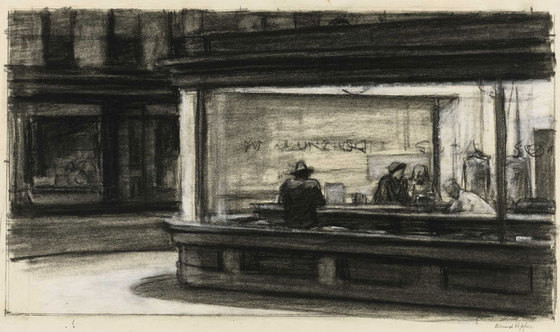Hopper Drawing
23 May - 06 Oct 2013

Edward Hopper (1882–1967)
Study for Nighthawks, 1941 or 1942
Fabricated chalk and charcoal on paper
11 1/8 × 15 in. (28.3 × 38.1 cm).
Whitney Museum of American Art, New York; purchase and gift of Josephine N. Hopper by exchange 2011.65
Study for Nighthawks, 1941 or 1942
Fabricated chalk and charcoal on paper
11 1/8 × 15 in. (28.3 × 38.1 cm).
Whitney Museum of American Art, New York; purchase and gift of Josephine N. Hopper by exchange 2011.65
HOPPER DRAWING
23 May – 6 October 2013
Hopper Drawing is the first major museum exhibition to focus on the drawings and creative process of Edward Hopper (1882–1967). More than anything else, Hopper’s drawings reveal the continually evolving relationship between observation and invention in the artist’s work, and his abiding interest in the spaces and motifs—the street, the movie theatre, the office, the bedroom, the road—that he would return to throughout his career as an artist. This exhibition showcases the Whitney’s unparalleled collection of Hopper’s work, which includes over 2,500 drawings bequeathed to the museum by his widow Josephine Hopper, many of which have never before been exhibited or researched. The exhibition will survey Hopper’s significant and underappreciated achievements as a draftsman, and will pair many of his greatest oil paintings, including Early Sunday Morning (1930), New York Movie (1939), Office at Night (1940) and Nighthawks (1942), with their preparatory drawings and related works. This exhibition also features groundbreaking archival research into the buildings, spaces and urban environments that inspired his work.
Hopper Drawing is organized by Carter E. Foster, Steven and Ann Ames Curator of Drawing.
23 May – 6 October 2013
Hopper Drawing is the first major museum exhibition to focus on the drawings and creative process of Edward Hopper (1882–1967). More than anything else, Hopper’s drawings reveal the continually evolving relationship between observation and invention in the artist’s work, and his abiding interest in the spaces and motifs—the street, the movie theatre, the office, the bedroom, the road—that he would return to throughout his career as an artist. This exhibition showcases the Whitney’s unparalleled collection of Hopper’s work, which includes over 2,500 drawings bequeathed to the museum by his widow Josephine Hopper, many of which have never before been exhibited or researched. The exhibition will survey Hopper’s significant and underappreciated achievements as a draftsman, and will pair many of his greatest oil paintings, including Early Sunday Morning (1930), New York Movie (1939), Office at Night (1940) and Nighthawks (1942), with their preparatory drawings and related works. This exhibition also features groundbreaking archival research into the buildings, spaces and urban environments that inspired his work.
Hopper Drawing is organized by Carter E. Foster, Steven and Ann Ames Curator of Drawing.
